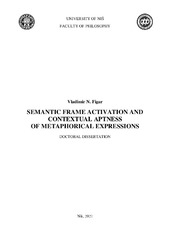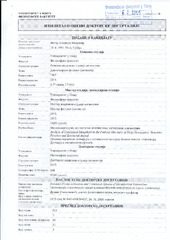Prikaz osnovnih podataka o disertaciji
Semantic frame activation and contextual aptness of metaphorical expressions
| dc.contributor.advisor | Stamenković, Dušan | |
| dc.contributor.other | Silaški, Nadežda | |
| dc.contributor.other | Tasić, Miloš | |
| dc.creator | Figar, Vladimir | |
| dc.date.accessioned | 2022-11-13T14:32:33Z | |
| dc.date.available | 2022-11-13T14:32:33Z | |
| dc.date.issued | 2021-12-09 | |
| dc.identifier.uri | http://eteze.ni.ac.rs/application/showtheses?thesesId=8511 | |
| dc.identifier.uri | https://fedorani.ni.ac.rs/fedora/get/o:1779/bdef:Content/download | |
| dc.identifier.uri | https://plus.cobiss.net/cobiss/sr/sr/bib/53843465 | |
| dc.identifier.uri | https://nardus.mpn.gov.rs/handle/123456789/20869 | |
| dc.description.abstract | The study aims to explore the possibility of semantic frame activation and interaction in metaphorical expressions, and the conditions of contextual aptness of metaphorical expressions. To ensure the appropriate level of ecological validity, experimental stimuli have been selected from a corpus of newspaper articles, and included in the norming procedures. The theoretical framework includes the investigations into context and semantic frames, semantic priming, discourse processing, conceptual metaphor theory, and psycholinguistic approaches to metaphor. The first four experiments were designed to test the activation and interaction of the organizing frames of source and target inputs in metaphorical expressions from the conceptual keys of CONFLICT and MOTION. This included an online priming paradigm with a categorization task, and the main dependent variable of interest was response time (RT). Stimuli were presented in (1) congruent metaphorical (metaphorical sentences), (2) congruent literal (literal sentences), and (3) incongruent conditions (unrelated sentences). Targets were individual words from the relevant frames. The results showed higher degrees of activation of the organizing frames of target inputs for both metaphor groups. There were no significant differences between the two congruent conditions, while RTs in the incongruent condition were significantly longer. The data seem to offer support for the interaction view of metaphor processing. The final two experiments tested the level of contextual aptness of target metaphorical expressions from the same two conceptual keys, in (1) congruent metaphorical (metaphor clusters), (2) congruent literal (literal paragraphs), and (3) incongruent priming conditions (unrelated paragraphs). Targets were metaphorical sentences from the two conceptual keys. The obtained results did not reveal any differences between the two congruent conditions, while the recorded RTs were significantly shorter in the incongruent condition. Overall, the study provides empirical insight into the phenomena of (metaphorical) framing, frame activation and interaction, and contextualization, and their import in online meaning construction. | en |
| dc.format | application/pdf | |
| dc.language | sr | |
| dc.publisher | Универзитет у Нишу, Филозофски факултет | sr |
| dc.rights | openAccess | en |
| dc.rights.uri | https://creativecommons.org/licenses/by-nc-nd/4.0/ | |
| dc.source | Универзитет у Нишу | sr |
| dc.subject | Semantički okviri | sr |
| dc.subject | Semantic frames | en |
| dc.subject | kategorizacija | sr |
| dc.subject | kontekst | sr |
| dc.subject | pojmovna metafora | sr |
| dc.subject | semantičko primovanje | sr |
| dc.subject | vreme reakcije | sr |
| dc.subject | categorization | en |
| dc.subject | context | en |
| dc.subject | conceptual metaphor | en |
| dc.subject | semantic priming | en |
| dc.subject | reaction times | en |
| dc.title | Semantic frame activation and contextual aptness of metaphorical expressions | sr |
| dc.type | doctoralThesis | |
| dc.rights.license | BY-NC-ND | |
| dc.identifier.fulltext | http://nardus.mpn.gov.rs/bitstream/id/147192/Figar_Vladimir_N.pdf | |
| dc.identifier.fulltext | http://nardus.mpn.gov.rs/bitstream/id/147191/Doctoral_thesis_12827.pdf | |
| dc.identifier.rcub | https://hdl.handle.net/21.15107/rcub_nardus_20869 |



